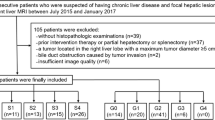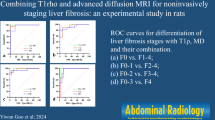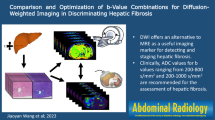Abstract
Purpose
To investigate and compare the diagnostic value of diffusion kurtosis imaging (DKI) with diffusion-weighted imaging (DWI) in assessing and quantifying hepatic fibrosis.
Methods
Thirty rats were divided into the control group (n = 6) and the fibrosis experimental groups (n = 6 per group) with CCl4 administration for 2, 4, 6, and 8 weeks. Liver fibrosis stage (S) and necroinflammatory activity grade (G) were histopathologically determined. DKI and DWI were performed; mean apparent diffusion (MD), mean kurtosis (MK), and apparent diffusion coefficient (ADC) values were calculated. DKI parameters were compared with ADC values according to G/S scores.
Results
Strong inverse correlations were found between the degree of fibrosis and both MD and ADC (r = −0.840 and r = −0.760), while only weak correlation existed in MK (r = 0.405). ROC analyses demonstrated the AUC in MD, MK, and ADC of 0.862, 0.684, 0.817 for identifying mild and severe fibrosis, and 0.757, 0.675, 0.733 for non-cirrhosis and cirrhosis, respectively. The degree of fibrosis was significantly correlated with α-smooth muscle actin (α-SMA) (P < 0.0001); α-SMA had strong inverse correlation with MD (r = −0.723), moderate inverse correlation with ADC (r = −0.613), and very weak correlation with MK (r = 0.175). Additionally, MD was strongly correlated with the necroinflammatory activity (r = −0.758), ADC was moderately correlated (r = −0.492), and MK was weakly correlated (r = 0.254).
Conclusion
DKI may provide added information and serve as a valuable tool for the characterization and surveillance of liver fibrosis in a non-invasive manner.




Similar content being viewed by others
References
Faria SC, Ganesan K, Mwangi I, et al. (2009) MR imaging of liver fibrosis: current state of the art. Radiographics 29:1615–1636
Li F, Song Z, Li Q, et al. (2011) Molecular imaging of hepatic stellate cell activity by visualization of hepatic integrin alpha v beta 3 expression with SPECT in rat. Hepatology 54:1020–1030
Ding Y, Rao SX, Zhu T, et al. (2015) Liver fibrosis staging using T1 mapping on gadoxetic acid-enhanced MRI compared with DW imaging. Clin Radiol 70:1096–1103
Trautwein C, Friedman SL, Schuppan D, Pinzani M (2015) Hepatic fibrosis: concept to treatment. J Hepatol 62:S15–S24
Yoon JH, Lee JM, Baek JH, et al. (2014) Evaluation of hepatic fibrosis using intravoxel incoherent motion in diffusion-weighted liver MRI. J Comput Assist Tomogr 38:110–116
Venkatesh SK, Wang G, Lim SG, Wee A (2014) Magnetic resonance elastography for the detection and staging of liver fibrosis in chronic hepatitis B. Eur Radiol 24:70–78
Rosenkrantz AB, Sigmund EE, Winnick A, et al. (2012) Assessment of hepatocellular carcinoma using apparent diffusion coefficient and diffusion kurtosis indices: preliminary experience in fresh liver explants. Magn Reson Imaging 30:1534–1540
Jensen JH, Helpern JA, Ramani A, Lu HZ, Kaczynski K (2005) Diffusional kurtosis imaging: the quantification of non-Gaussian water diffusion by means of magnetic resonance imaging. Magn Reson Med 53:1432–1440
Goshima S, Kanematsu M, Noda Y, et al. (2015) Diffusion kurtosis imaging to assess response to treatment in hypervascular hepatocellular carcinoma. AJR Am J Roentgenol 204:W543–W549
Anderson SW, Barry B, Soto J, et al. (2014) Characterizing non-Gaussian, high b-value diffusion in liver fibrosis: stretched exponential and diffusional kurtosis modeling. J Magn Reson Imaging 39:827–834
Lagadec M, Doblas S, Giraudeau C, et al. (2015) Advanced fibrosis: correlation between pharmacokinetic parameters at dynamic gadoxetate-enhanced MR imaging and hepatocyte organic anion transporter expression in rat liver. Radiology 274:379–386
Dong D, Yin L, Qi Y, Xu L, Peng J (2015) Protective effect of the total saponins from Rosa laevigata Michx fruit against carbon tetrachloride-induced liver fibrosis in rats. Nutrients 7:4829–4850
Bedossa P, Poynard T (1996) An algorithm for the grading of activity in chronic hepatitis C. Hepatology 24:289–293
Karlik SJ (2003) Exploring and summarizing radiologic data. AJR Am J Roentgenol 180:47–54
Polasek M, Fuchs BC, Uppal R, et al. (2012) Molecular MR imaging of liver fibrosis: a feasibility study using rat and mouse models. J Hepatol 57:549–555
Nishie A, Asayama Y, Ishigami K, et al. (2012) MR prediction of liver fibrosis using a liver-specific contrast agent: superparamagnetic iron oxide versus Gd-EOB-DTPA. J Magn Reson Imaging 36:664–671
Cheung JS, Fan SJ, Chow AM, Hui ES, Wu EX (2009) In vivo DTI assessment of hepatic ischemia reperfusion injury in an experimental rat model. J Magn Reson Imaging 30:890–895
Taouli B, Chouli M, Martin AJ, et al. (2008) Chronic hepatitis: role of diffusion-weighted imaging and diffusion-tensor imaging for the diagnosis of liver fibrosis and inflammation. J Magn Reson Imaging 28:89–95
Rosenkrantz AB, Padhani AR, Chenevert TL, et al. (2015) Body diffusion kurtosis imaging: basic principles, applications, and considerations for clinical practice. J Magn Reson Imaging 42:1190–1202
Guido M, Mangia A, Faa G (2011) Chronic viral hepatitis: the histology report. Dig Liver Dis 43(Suppl 4):S331–S343
Lee JT, Liau J, Murphy P, et al. (2012) Cross-sectional investigation of correlation between hepatic steatosis and IVIM perfusion on MR imaging. Magn Reson Imaging 30:572–578
Author information
Authors and Affiliations
Corresponding author
Ethics declarations
Funding
This study was funded by the National Natural Science Foundation for Young Scientists of China (grant number 81601488), the Shanghai Sailing Program (grant number 16YF1410600), and the National Natural Science Foundation of China (grant number 81571661).
Conflict of interest
The authors declare that they have no conflict of interest.
Ethical approval
All applicable international, national, and/or institutional guidelines for the care and use of animals were followed. All procedures performed in studies involving animals were in accordance with the ethical standards of the institution or practice at which the studies were conducted.
Informed consent
Statement of informed consent was not applicable since the manuscript does not contain any patient data.
Rights and permissions
About this article
Cite this article
Sheng, R.F., Wang, H.Q., Yang, L. et al. Diffusion kurtosis imaging and diffusion-weighted imaging in assessment of liver fibrosis stage and necroinflammatory activity. Abdom Radiol 42, 1176–1182 (2017). https://doi.org/10.1007/s00261-016-0984-4
Published:
Issue Date:
DOI: https://doi.org/10.1007/s00261-016-0984-4




